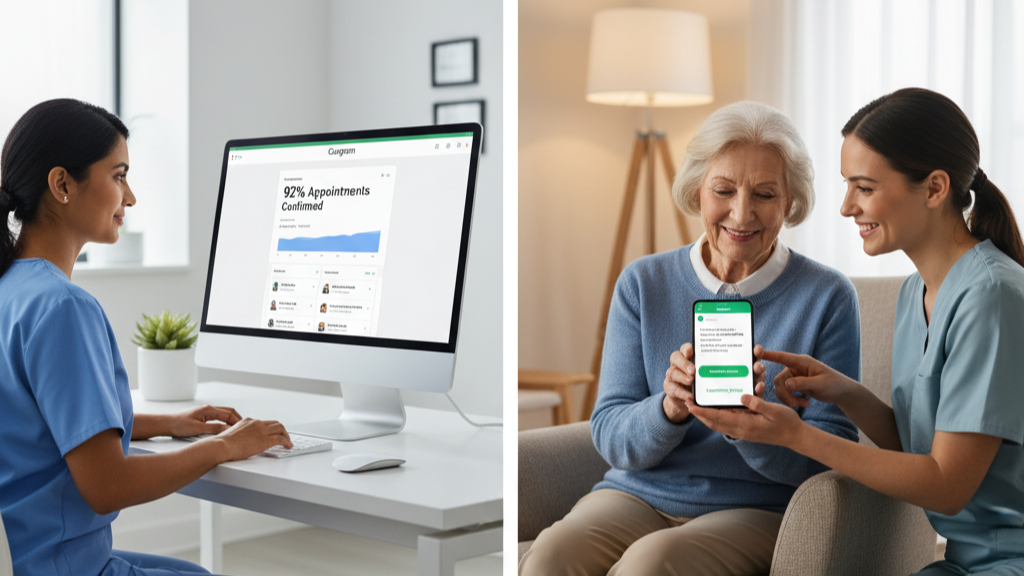What Is Patient Experience in Healthcare (and Why It Matters)
💡Patient experience in healthcare goes beyond medical outcomes. It includes every interaction a patient has with a clinic. This ranges from...
7 min read
Gregory Vic Dela Cruz : September 8, 2025

The healthcare industry is shifting. Patients are no longer passive participants. They don't simply show up to appointments and follow instructions without question. Instead, they want to be active partners in their care. This change has put patient engagement in healthcare at the center of attention.
Engagement means more than sending reminders or handing out pamphlets. It requires ongoing communication, education, and support. This in turn empowers patients to take control of their health. Engaged patients make informed decisions and manage chronic conditions more effectively. Hence, they stay loyal to their providers. On the other hand, clinics that neglect engagement see a different picture. They risk higher no-show rates, reduced satisfaction, and weaker financial performance.
This article will define what is patient engagement in healthcare and why it matters. We’ll explore the difference between patient engagement and patient experience. Let's learn the common barriers to engagement and discover proven strategies. By the end, you’ll understand why engagement is not just a nice-to-have. It’s also critical for patient care and clinic success.
Patient engagement in healthcare is the active participation of patients in their own care. It goes beyond showing up for visits. Patients are informed, involved, and empowered to make decisions that affect their health. Engagement means patients understand their conditions, follow treatment plans, and use available tools to stay connected to providers. It requires clinics to create opportunities for patients to ask questions, receive clear answers, and access care in convenient ways.
Patient engagement and patient experience are often confused but are not the same. Patient experience measures how patients feel during interactions with the healthcare system. This includes wait times, communication, and how respectful staff are. Patient engagement measures the actions patients take based on those interactions. For example, a positive experience may make patients more likely to engage, but true engagement is when they follow care instructions, complete digital forms, or actively use portals to track their health. Both concepts are linked, but engagement drives measurable outcomes.
Healthcare systems worldwide are prioritizing engagement because it improves both quality and efficiency. Clinics with strong patient engagement strategies see fewer hospital readmissions, lower no-show rates, and better outcomes for chronic disease management. Insurance companies and regulators are also tying reimbursements and ratings to patient engagement and patient experience scores. Clinics that embrace engagement position themselves as forward-thinking, while those that ignore it risk losing patients to competitors offering digital-first, patient-centered care.
Engaged patients are proactive about their health. They adhere to medication schedules, attend preventive screenings, and manage chronic conditions more effectively. This reduces costly emergency visits and leads to longer-term wellness. Engagement directly supports population health goals.
Patients want to feel heard and supported. Engagement tools like HIPAA-compliant communication, secure texting, and automated reminders keep them informed and valued. Satisfied patients are more loyal, less likely to switch providers, and more likely to recommend their clinic.
Engagement benefits clinics as much as patients. When patients confirm visits, complete digital intake, and use portals for information, staff workloads decrease. This reduces administrative bottlenecks and improves scheduling accuracy. Clinics that adopt digital patient engagement see smoother workflows and fewer errors.
No-shows drain resources and revenue. Patient engagement tools like smart reminders and digital scheduling reduce missed appointments by up to 30 percent. Capturing more appointments and reducing gaps in scheduling directly improves provider utilization and financial stability.
One of the biggest barriers to patient engagement is limited access to digital tools. Patients without reliable internet or devices may struggle to complete online intake or use portals. Clinics must offer alternatives while continuing to expand digital access to bridge this gap.
Patients who do not understand medical terminology may feel overwhelmed. This reduces their willingness to ask questions or follow care plans. Providers need to communicate in plain language and confirm understanding. Patient engagement examples show that when communication improves, engagement increases significantly.
Staff may resist adopting new patient engagement tools if they perceive them as extra work. Training and integration are essential. When tools are seamlessly connected to systems like eCW, workflows improve rather than add burdens. Leadership must highlight the long-term benefits for both staff and patients.
Patients are rightly concerned about how their health data is used. HIPAA-compliant communication tools address this by encrypting data and keeping audit logs. Clinics that emphasize security reduce patient hesitation and encourage trust in digital engagement systems.
Language barriers, cultural differences, and socioeconomic status can all affect engagement. Clinics should provide multilingual materials, culturally sensitive communication, and financial counseling. Addressing these barriers ensures equitable access to patient engagement in healthcare for all populations.
.png?width=1536&height=1024&name=what%20is%20patient%20engagement%20in%20healthcare%20and%20why%20it%20matters%20-%20mid%20(1).png)
Effective communication is the backbone of patient engagement in healthcare. Patients want to reach their providers easily and receive clear, timely responses. Two-way text messaging offers a convenient channel for quick questions, confirmations, and clarifications. Secure platforms ensure all communication is HIPAA-compliant, reducing risk while making patients feel supported. Strong communication keeps patients informed, prevents confusion, and builds trust between visits.
Engagement is impossible without education. Patients need clear instructions about medications, treatment plans, and preventive care. Clinics can use digital tools to share videos, infographics, and tailored resources. Providing ongoing education ensures patients understand their role in care. This reduces errors, increases adherence to treatment, and empowers patients to make informed decisions about their health.
Convenience drives participation. When patients can schedule appointments online, fill out digital intake forms, and receive automated reminders, they are more likely to stay engaged. Convenience reduces barriers that often discourage patients from taking action. By streamlining administrative steps, clinics create a smoother patient journey while saving staff time.
Patients want to know their opinions matter. Feedback mechanisms such as surveys, online reviews, and post-visit follow-ups give patients a voice. Collecting and acting on feedback shows a commitment to continuous improvement. It also provides clinics with actionable insights to refine workflows, improve communication, and strengthen loyalty. Feedback is not just about reputation—it’s about building relationships based on listening and adapting.
No-shows disrupt schedules and cost clinics revenue. Automated appointment reminders reduce missed visits by sending patients timely notifications. Two-way reminders allow patients to confirm or reschedule easily, ensuring calendars stay accurate and utilization remains high.
Paper intake forms cause delays and errors. Digital intake forms let patients complete paperwork before visits, cutting down check-in times and improving accuracy. Integrated with the EMR, these forms reduce administrative burden while making the process smoother for patients.
Secure texting platforms allow clinics to answer questions, share updates, and handle follow-ups quickly. HIPAA-compliant communication ensures sensitive information is protected. Patients appreciate the immediacy of texting compared to voicemails or phone tag, leading to higher engagement and satisfaction.
Telehealth extends care beyond the clinic walls. It provides patients with convenient access to providers without travel, reducing missed visits and expanding reach to underserved areas. Telehealth is especially valuable for chronic care management and follow-ups, ensuring consistent engagement between in-person visits.
Bulk messaging enables clinics to reach hundreds of patients at once with important updates or health campaigns. Clinics can notify patients about flu shots, new services, or seasonal care reminders. Outreach builds stronger connections while encouraging patients to take preventive actions that improve outcomes.
A primary care group used bulk messaging to encourage patients due for annual checkups and screenings. Within months, preventive visit rates rose by 20 percent. Patients appreciated the reminders and the ease of scheduling directly through a secure link.
A specialty clinic treating patients with chronic conditions implemented automated reminders for medications and follow-up visits. As a result, adherence to care plans improved significantly, reducing complications and hospital readmissions. Engagement tools turned complex care into manageable routines for patients.
A multi-location provider adopted a feedback system that sent review requests after visits. Positive reviews were published on Google, while negative feedback was routed internally. Within nine months, the group gained thousands of 5-star reviews, improving trust and visibility. Patients saw a provider that valued their opinions and responded to concerns.
Curogram integrates directly with eClinicalWorks, eliminating manual entry and ensuring every communication flows into the EMR. Patients receive reminders, complete forms, and send secure messages—all synced in real time. This integration saves staff hours each week and ensures data accuracy.
Automation is key to scaling engagement. Curogram automates reminders, confirmations, intake, and feedback collection, reducing staff workload. Clinics engage patients consistently without adding extra administrative burdens. Staff gain time for in-clinic interactions while patients enjoy streamlined communication.
Patients are increasingly concerned about privacy. Curogram ensures all interactions are HIPAA-compliant and SOC 2 certified, protecting patient data while providing the convenience of texting and digital forms. This commitment to security builds trust and encourages patients to engage more openly with their providers.
A strong strategy supported by the right tools, real-world examples, and secure integration with eCW allows clinics to overcome barriers to patient engagement. Curogram makes it easier to automate processes, protect data, and deliver the kind of care patients expect in a digital-first healthcare system.
Patient engagement in healthcare is the foundation of effective, modern care. Engaged patients achieve better outcomes and build stronger relationships with providers. Thus, they help clinics grow sustainably.
Barriers like lack of access, low health literacy, and privacy concerns slow progress. However, they are not insurmountable. Clinics that adopt digital engagement tools and secure communication platforms overcome these obstacles. Real-world patient engagement examples show that engagement improves outcomes and reduces costs.
For eCW users, Curogram features an all-in-one solution. It provides HIPAA-compliant communication, customizable forms, and automated reminders. These features simplify workflows and take your patient engagement to the next level. Want to transform how your clinic connects with patients? Get a demo today.
.png)
💡Patient experience in healthcare goes beyond medical outcomes. It includes every interaction a patient has with a clinic. This ranges from...

Patient engagement has increasingly become more critical in every healthcare organization, from hospitals to small medical practices. So, how will...
.png)
💡After-hours patient communication is one of the biggest challenges in modern healthcare. Patients don’t only need help between 9 and 5. They call...